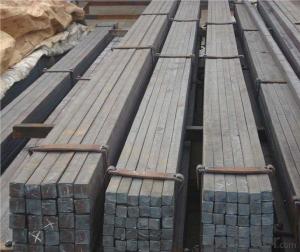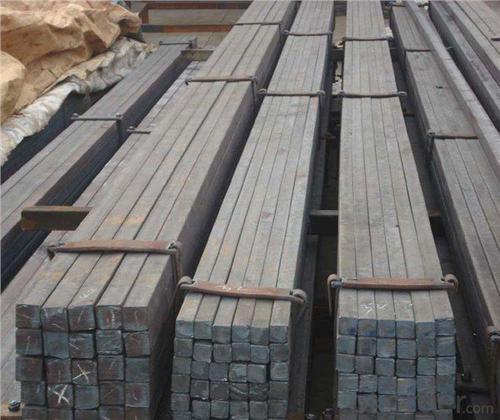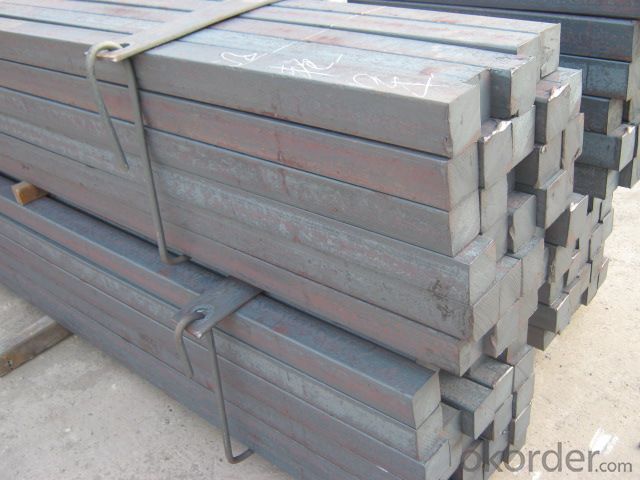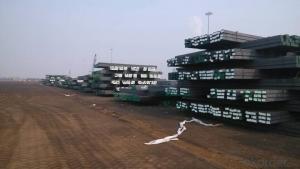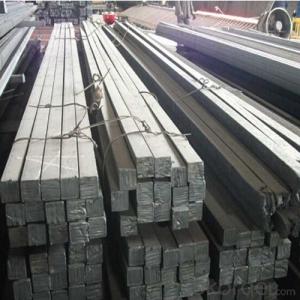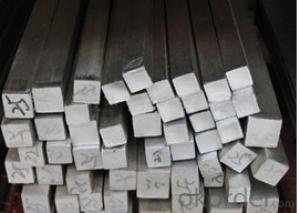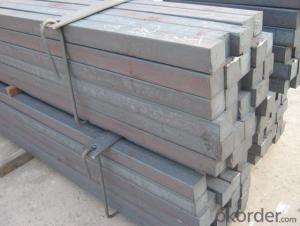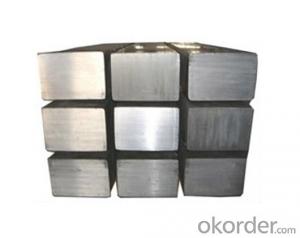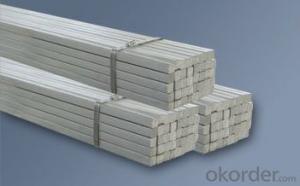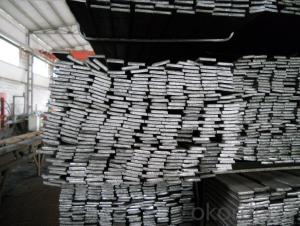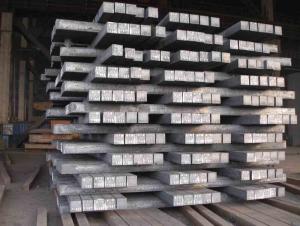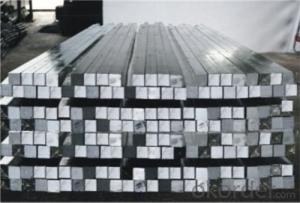Steel Square Bar High Quality 5mm-100mm Q195 or Q235
- Loading Port:
- Shanghai
- Payment Terms:
- TT or LC
- Min Order Qty:
- 50 m.t.
- Supply Capability:
- 20000 m.t./month
OKorder Service Pledge
OKorder Financial Service
You Might Also Like
Product Description:
OKorder is offering High Quality Square Bar 5mm-100mm Q195 or Q235 at great prices with worldwide shipping. Our supplier is a world-class manufacturer of steel, with our products utilized the world over. OKorder annually supplies products to European, North American and Asian markets. We provide quotations within 24 hours of receiving an inquiry and guarantee competitive prices.
Product Applications:
1) Suitable for making various strong cutting tool abrasion resistance, impact resistance.
2) Used to produce all kinds of high hard and super hard saw blade, drill, tap, broach, gear hob and various kinds of milling cutter.
3) Used for advanced punching die, screw die, and the toughness and complicated shape of the punch, etc.
4) Is used for cold forging die and drawing mode, etc.
5) Recommended watchcase factory, screw factory and other cold stamping products industry use.
Product Advantages:
OKorder's High Quality Square Bar 5mm-100mm Q195 or Q235 are durable, strong, and resist corrosion.
Main Product Features:
· Premium quality
· Prompt delivery & seaworthy packing (30 days after receiving deposit)
· Corrosion resistance
· Can be recycled and reused
· Mill test certification
· Professional Service
· Competitive pricing
Product Specifications:
Standard: GB,
-Grade: Q195 or equivalent.
-Chemical Composition:
Standard | Grade | Element (%) | ||||
GB | Q195 | C | Mn | S | P | Si |
0.06~0.12 | 0.25~0.50 | ≤0.050 | ≤0.045 | ≤0.30 | ||
Measures of HR Square Bar (small measures):
-Length of a side and Theoretical weight of Square Bar.
Length of a side(mm) | Theoretical weight(kg/m) | Length of a side(mm) | Theoretical weight(kg/m) |
7 | 0.385 | 22 | 3.80 |
8 | 0.502 | 24 | 4.52 |
9 | 0.636 | 25 | 4.91 |
10 | 0.785 | 26 | 5.30 |
11 | 0.950 | 28 | 6.15 |
12 | 1.13 | 30 | 7.06 |
13 | 1.33 | 32 | 8.04 |
14 | 1.54 | 34 | 9.07 |
15 | 1.77 | 36 | 10.17 |
16 | 2.01 | 38 | 11.24 |
17 | 2.27 | 40 | 12.56 |
18 | 2.54 | 42 | 13.85 |
19 | 2.82 | 45 | 15.90 |
20 | 3.14 | 48 | 18.09 |
21 | 3.46 | 50 | 19.63 |
Notes:
1, The theoretical weights in the list, base on the density of 7.85 g/cm3.
2, Formula for theoretical weight of Square bar: (length of a side)2 * 0.00785
3, The numbers with *mean that they are not regular or we don’t offer them.
-Regular length of Square Bar:
Steel | Length of a side (mm) | Length of steel (m) |
Normal steel | < 25 | 4~10 |
> 25 | 3~9 | |
Steel of high quality | All measure | 2~6 |
Tool steel >75 | 1~6 |
FAQ:
Q1: Why buy Materials & Equipment from OKorder.com?
A1: All products offered byOKorder.com are carefully selected from China's most reliable manufacturing enterprises. Through its ISO certifications, OKorder.com adheres to the highest standards and a commitment to supply chain safety and customer satisfaction.
Q2: How do you package the angle steel when shipping?
A2: All goods are packed in bundles with steel strips and shipped by container or break bulk.
Q3: The products are invoicing on theoritical weight or on actual weight?
A3: We can do it in both manners, according to the customers' request.

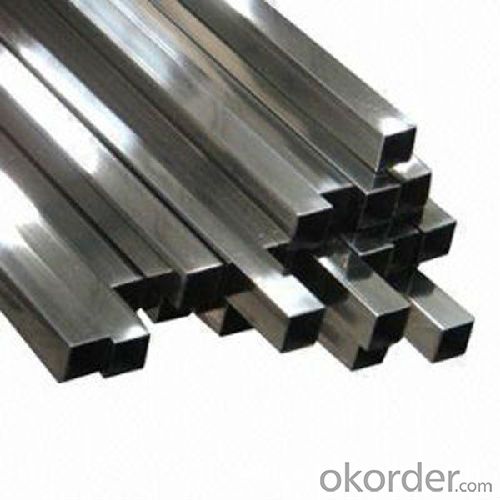
- Q: What are the different parts of a steel square?
- A steel square, also referred to as a framing square or carpenter's square, is composed of multiple essential components that contribute to its functionality. The primary elements of a steel square are as follows: 1. Blade: On one side of the square, there is a lengthy, flat metal surface known as the blade. It is typically inscribed with measurements and angles, enabling precise measurements and layout work. 2. Tongue: Located at the end of the blade, the tongue is a shorter segment of metal. Positioned perpendicular to the blade, it is commonly utilized to mark and measure short distances. 3. Heel: Positioned opposite to the tongue, the heel represents the wider end of the steel square. It serves as a stable platform and acts as a reference point for creating square cuts and angles. 4. Face: The face, which is perpendicular to both the blade and tongue, denotes the flat part of the square. It is commonly employed for drawing straight lines and verifying the squareness of corners. 5. Fence: Along the face of the square, there is an elevated edge called the fence. It aids in securely holding the square against the workpiece, ensuring accurate measurements and straight lines. 6. Graduations: The blade and face of the square exhibit markings or measurements referred to as graduations. These graduations facilitate precise measurements of distances, angles, and cuts. 7. Squaring and Angle Scales: Typically located on the face of the square, squaring and angle scales are employed to measure angles other than 90 degrees. They prove useful for marking angles, bevels, and intricate cuts. 8. Rafter Tables: Certain steel squares incorporate rafter tables, which are engraved charts or tables found on the blade. These tables provide information and calculations for various roof framing applications, such as determining rafter lengths and angles. In summary, the diverse components of a steel square collaboratively contribute to accuracy, stability, and versatility for various carpentry and layout tasks.
- Q: Can a steel square be used for measuring door and window openings?
- A steel square, also called a framing square or carpenter's square, is a versatile tool widely employed in construction and carpentry. It is capable of measuring door and window openings accurately. This tool typically possesses a 90-degree angle and a lengthier blade, which serves the purpose of measuring and marking straight lines. Additionally, the shorter blade can be utilized for measuring various angles, including 45 degrees or 30 degrees. To ensure precise and square measurements, a steel square can be utilized when measuring door and window openings. By placing it against the edges of the opening, one can determine if they are perfectly perpendicular or if any adjustments are necessary. The width and height of the opening can be measured using the longer blade, while the shorter blade serves to verify if the corners are square. In conclusion, a steel square is a dependable tool that can be used to measure door and window openings, guaranteeing their proper alignment and squareness.
- Q: How do you use a steel square to check for flatness?
- To use a steel square to check for flatness, place it on the surface you want to test. Check if all four sides of the square are in contact with the surface. If there are gaps or the square rocks, it indicates that the surface is not flat.
- Q: Can a steel square be used for concrete formwork layout?
- Yes, a steel square can be used for concrete formwork layout. The steel square is a versatile and accurate tool that can be used to measure, mark, and layout various angles and dimensions required for concrete formwork. Its sturdy construction and precise measurements make it suitable for ensuring the proper alignment and positioning of formwork components during concrete construction.
- Q: What are some common applications of a steel square in metalworking?
- Some common applications of a steel square in metalworking include marking and measuring right angles, checking the accuracy of angles and corners, setting up machinery and equipment, and ensuring proper alignment during welding and fabrication processes.
- Q: How do you use a steel square to measure and mark 50.625-degree angles?
- To use a steel square to measure and mark a 50.625-degree angle, follow these steps: 1. Start by confirming that your steel square has a protractor scale on one of its sides. This protractor scale is usually marked in degrees. 2. Place the steel square on a flat surface, ensuring that it is stable and not wobbling. 3. Locate the zero-degree mark on the protractor scale. This mark is typically positioned at one of the corners of the steel square. 4. Align the edge of the steel square with the line or surface on which you want to measure and mark the angle. 5. Look for the angle measurement that is closest to 50.625 degrees on the protractor scale. Since steel squares usually have graduations in whole degrees, you may need to estimate and approximate the desired angle. 6. Once you have identified the closest angle measurement, make a small mark on the line or surface at the corresponding point on the protractor scale. 7. Using a straightedge or ruler, draw a line from the mark you made to the desired endpoint of the angle. 8. This line represents the 50.625-degree angle you want to measure and mark. It's important to note that steel squares are not typically designed for measuring and marking precise angles with decimal places. They are more commonly used for right angles (90 degrees) or other common angles like 45 degrees or 30 degrees. If you require a highly accurate measurement of a 50.625-degree angle, you may need to use a different measuring tool, such as a protractor or a digital angle gauge.
- Q: Can a steel square be used for checking the squareness of door jambs?
- Door jambs can be checked for squareness using a steel square. This versatile tool, also known as a framing square or carpenter's square, is commonly used in construction and woodworking. It consists of two arms that form a right angle, enabling precise measurements and angle marking. To check the squareness of a door jamb using a steel square, position the longer arm against one side of the jamb and the shorter arm against the adjacent side. Make sure both arms align perfectly with the edges of the jamb. Then, observe whether the square aligns perfectly with the jamb. If the jamb is square, the square's edges will run parallel to the sides of the jamb. If the square doesn't align perfectly with the jamb or there is a gap between the square and the jamb, it indicates that the jamb is not square. This can lead to issues with the door installation, such as problems with closing, opening, or proper latching. In such cases, adjustments may be necessary to ensure the jamb is square before proceeding with the door installation. In conclusion, a steel square is a reliable tool for checking the squareness of door jambs. It enables quick and accurate measurements, ensuring a proper door installation.
- Q: How do you use a steel square to measure the height of a door opening?
- To use a steel square to measure the height of a door opening, you would place the square vertically against the side of the door frame, ensuring it is flush with the top and bottom edges of the frame. Then, read the measurement indicated on the square where it aligns with the top of the frame, as this would give you the accurate height of the door opening.
- Q: What are some common techniques for using a steel square in cabinetry?
- A steel square, which is also referred to as a framing square or carpenter's square, is a tool that is widely used in cabinetry for the purpose of measuring and marking angles, thus guaranteeing precise cuts and joinery. Presented below are several customary methods for employing a steel square in cabinetry: 1. Squareness verification: One of the primary functions of a steel square is to ascertain if a corner is perfectly square. To accomplish this, position the square against the inside corner, and if the edge aligns with the adjacent edge, it indicates that the corner is square. This aids in ensuring that all corners of the cabinets are at right angles. 2. Indication of 45-degree cuts: The body of the steel square contains a 45-degree angle mark. By aligning the square with the material's edge, you can accurately mark a 45-degree angle for mitered cuts, such as those used for trim or decorative elements on cabinet doors and panels. 3. Marking of parallel lines: The lengthy edge of a steel square is utilized for marking parallel lines. Just align the square with the material's edge and draw a line along the other edge of the square. This technique is useful for marking the locations of shelves and cabinet bottoms or for ensuring parallel cuts. 4. Layout of cuts: The steel square is highly effective for marking precise lines for cuts. By aligning the square with the material's edge, you can draw a line perpendicular or parallel to the edge. This facilitates the marking of cuts for various cabinet components like shelves, drawer dividers, and door frames. 5. Determination of pitch and slope: A steel square can be utilized to determine the pitch or slope of a roof or any inclined surface. By placing the square on the surface, you can ascertain the degree of pitch or slope by referring to the markings on the square. 6. Measurement and transfer of dimensions: The steel square can also function as a ruler for the purpose of measuring and transferring dimensions. The body of the square typically features a scale on one or both edges, enabling you to measure and mark precise lengths or distances. All in all, a steel square is an indispensable tool in cabinetry, providing accuracy and versatility in terms of measuring, marking, and verifying angles. Whether you are constructing cabinets from scratch or making meticulous modifications, incorporating these common techniques will ensure that your cabinetry projects are executed with precision and craftsmanship.
- Q: Can a steel square be used for measuring and marking compound miter and bevel cuts?
- Yes, a steel square can be used for measuring and marking compound miter and bevel cuts. While a steel square is typically used for measuring and marking right angles, it can also be used to measure and mark angles for compound miter and bevel cuts. By using the measurements and angles provided by the steel square, you can accurately mark the cuts on your material before making them. However, it is important to note that for more precise and complex compound miter and bevel cuts, specialized tools like a miter saw or a bevel gauge may be necessary.
Send your message to us
Steel Square Bar High Quality 5mm-100mm Q195 or Q235
- Loading Port:
- Shanghai
- Payment Terms:
- TT or LC
- Min Order Qty:
- 50 m.t.
- Supply Capability:
- 20000 m.t./month
OKorder Service Pledge
OKorder Financial Service
Similar products
Hot products
Hot Searches
Related keywords


